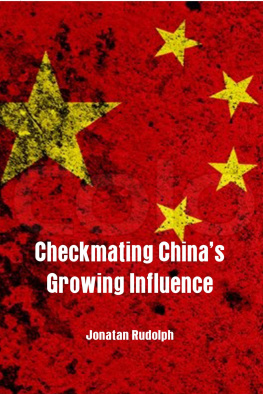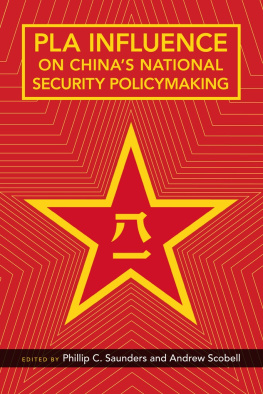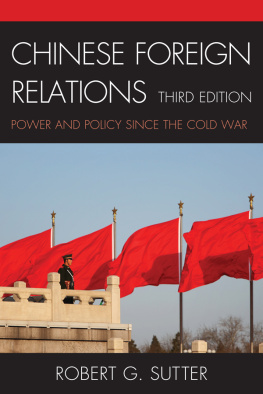Checkmating Chinas
Growing Influence
Checkmating Chinas
Growing Influence
Jonatan Rudolph
Alpha Editions
Copyright 2018
ISBN : 9789352978601
Design and Setting By
Alpha Editions
(A Vij Publishing Group Company)
www.vijbooks.com
email
All rights reserved. No part of this publication may be reproduced,
distributed, or transmitted in any form or by means, including
photocopying, recording, or other electronic or mechanical methods,
without the prior written permission of the publisher.
The views and characters expressed in the book are of the author
and his/her imagination and do not represent the views of the
Publisher.
The rise of China as an emerging power and as the most likely challenger to the global preponderance of the US is already having a significant impact across the globe. This phenomenon is being debated and analysed at various levels. In India too, it is generating a lot of excitement. On the one hand, it is considered to be an opportunity and on the other, a challenge.
The concern over Chinese intentions in the South China Sea is a driving factor feeding an increasing fear of Chinese actions. But what can the Chinese military actually do in the region? For the Peoples Liberation Army (PLA) in general and the PLA Navy (PLA-N) in particular the South China Sea disputes provided an excellent basis for justifying the need to modernize Chinas maritime forces. By focusing on the disputes in the South China Sea the risks and benefits on the political, economic, and military level were minimal as compared with other disputes, such as that with Japan over the Sengakus or the US over Taiwan. While the South China Sea represented the threat of foreign encroachment on Chinese territory, the threat was from small Southeast Asian states that the PLA-N believed it could easily handle. The distance from the mainland and the dangerous ground of the Spratlys meant that the naval forces would need to be a modern, technically proficient, combat-ready, long distance navy skilled in joint operations. On the non-military front, Chinas political and economic ties with the other claimants were also not as strong as those with Japan and the economic returns offered by the South China Sea could be substantial and immediate.
Chinas formidable naval presence in the Indian Ocean, all-weather friendship with Pakistan, growing influence in Nepal and Bangladesh, and increasing border skirmishes in Arunachal Pradhesh all are glaring indicators of Chinas intentions. The much-traded liberal argument that the deep-rooted economic engagements between the two countries would limit the possibility of the confrontation doesnt seem to convince anymore. Instead, an increasingly assertive China is likely to arrest Indias geostrategic and national interests. The most decisive counter therefore is to prepare for a disguised cold war in the region, which is imminent by its early signs.
Chinas use of regional and international organizations to institutionalize its power while either denying India access to these organizations or marginalizing India within them has added a new competitive dynamic to the relationship. In the past decade, India has found itself ranged against China at the UN Security Council, East Asia Summit, the Asia-Pacific Economic Cooperation, the Nuclear Suppliers Group, and the Asian Development Bank. In 2009, China vetoed a development plan for India by the latter in the disputed Arunachal Pradesh, thereby internationalizing a bilateral territorial dispute. In a tit-for-tat response, New Delhi has kept Beijing out of India-led multilateral frameworks such as the Bay of Bengal Initiative for Multi-Sectoral Technical and Economic Cooperation, the India-Brazil-South Africa Dialogue, and the MekongGanga Cooperation forums, and rejected Chinas request to be included as observer or associate member into the 33-member Indian Ocean Naval Symposium, started by India in 2008.
This is a reference book. All the matter is just compiled and edited in nature, taken from the various sources which are in public domain.
The book covers China`s role in Global power dynamics -competition or cooperation with major powers and its neighbours and its power status. Strategic implications of China`s Rise dictate the courses of action to be adopted by the United States whom it intends to displace and its immediate neighbour India.
Editor
Growing of Chinas Military
Capability and Strategy
The concern over Chinese intentions in the South China Sea is a driving factor feeding an increasing fear of Chinese actions. But what can the Chinese military actually do in the region? For the Peoples Liberation Army (PLA) in general and the PLA Navy (PLA-N) in particular the South China Sea disputes provided an excellent basis for justifying the need to modernize Chinas maritime forces. By focusing on the disputes in the South China Sea the risks and benefits on the political, economic, and military level were minimal as compared with other disputes, such as that with Japan over the Sengakus or the US over Taiwan. While the South China Sea represented the threat of foreign encroachment on Chinese territory, the threat was from small Southeast Asian states that the PLA-N believed it could easily handle. The distance from the mainland and the dangerous ground of the Spratlys meant that the naval forces would need to be a modern, technically proficient, combat-ready, long distance navy skilled in joint operations. On the non-military front, Chinas political and economic ties with the other claimants were also not as strong as those with Japan and the economic returns offered by the South China Sea could be substantial and immediate.
In the 1980s the PLA began to recognize that future international conflict would be of a limited nature with threats to the Chinese periphery rather than the heartland. In these conflicts victory would be dependent on high technology weapons, electronic warfare, highly motivated and well-trained troops, ground, air and sea mobility, and the ability to inflict maximum damage while not being bogged down in a protracted engagement. In 1985, the PLAN began to identify the need to shift from coastal defence to offshore defence. This strategy had the additional task of supporting and protecting economic and developmental projects in the waters surrounding the mainland. In light of this change it was decided that the PLA-N would require a nuclear submarine capability, a mobile force capable of responding to a variety of incidents in ocean conditions, and fortified positions where troops could be based and from which combat operations could be mounted. The adoption of this offshore defence strategy had important implications for the South China Sea as the Paracels and the Spratlys were now included in the area of operations. The new strategy also required the development of new equipment, such as surface and sub-surface warships and aircraft capable of operating farther from the Chinese coastal areas.
In 1986, the then-assistant commander-in-chief of the PLA-N, Zhang Xusan, argued that as naval operations are usually conducted far away from home bases it is important for the navy to have the capability to be able to detect and interdict an enemy invasion fleet quickly. It would therefore be necessary to concentrate on the development of highly mobile forces of high combat effectiveness in order to engage the enemy at the earliest possible time. In addition, it would be necessary for the navy to become familiar with the waters out to the first islands chain. Over the next few years senior Chinese PLA-N officers advocated that, due to the increased threats emanating from the sea and in order to safeguard the waters inside the first islands chain, the navy would need to be modernized.











